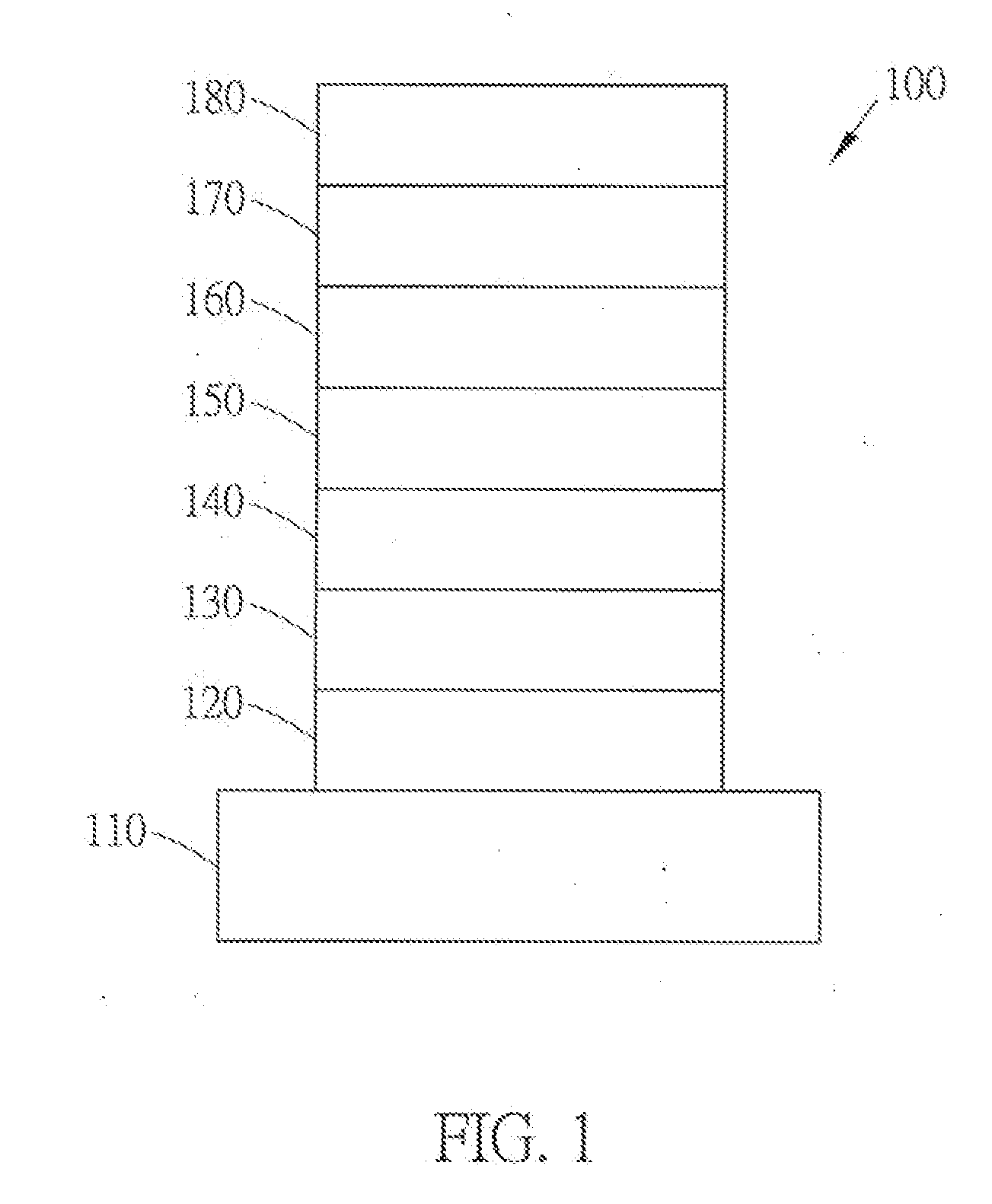Carbazole derivative and organic electroluminescent devices utilizing the same and fabrication method thereof
a technology of carbazole and organic electroluminescence, which is applied in the direction of thermoelectric devices, organic chemistry, anthracene dyes, etc., can solve the problem of difficult to find organic materials that meet all the requirements for use in practical display applications
- Summary
- Abstract
- Description
- Claims
- Application Information
AI Technical Summary
Benefits of technology
Problems solved by technology
Method used
Image
Examples
synthesis example 1
Synthesis of Compound 1-11
[0060]A mixture of 1.2 g of 9-acetyl-3-bromocarbazole and 2.2 g of N′-1-naphthyl-N,N-diphenyl-1,4-benzenediamine were stirred together in 20 ml N,N′-dimethylacetamide. To this was added 0.8 g of copper oxide and heated to 170° C. for 24 h. The reaction was quenched with water and the solid was filtered, washed with methanol, and dried under vacuum. The solid was then taken up for further deprotection using 0.6 g KOH with TI-IF (3 ml), methanol (6 ml) and water (6 ml) at reflux temperature. The reaction mixture was then extracted using ethyl acetate; and the organic layer was dried over anhydrous sodium sulfate and evaporated to dryness under vacuum. Subsequent silica gel column chromatography using toluene / hexane (½) as eluent, yielded 1.6 g of N-(9H-carbazol-3-yl)-N-(naphthalen-1-yl)-N′,N′-diphenylbenzene-1,4-diamine.
[0061]The above obtained N-(9H-carbazol-3-yl)-N-(naphthalen-1-yl)-N′,N′-diphenyl benzene-1,4-diamine (1.6 g) was dissolved in 30 ml of dry to...
synthesis example 2
Synthesis of Compound 1-16
[0064]Indolo[2,3-a]carbazole (9.8 g) was dissolved in 150 ml of dry toluene under nitrogen. 12.9 g of 3-bromo-p-terphenyl, 0.65 g of tris(dibenzylideneacetone) dipalladium, 0.46 g of tri-t-butylphosphine and 40.3 g of potassium orthophosphate were added and heated to reflux for 16 h. After the completion of reaction, the reaction was quenched with water. The reaction mixture was then extracted using ethyl acetate; and the organic layer was dried over anhydrous sodium sulfate and evaporated to dryness under vacuum. Subsequent silica gel column chromatography using ethyl acetate / hexane (1:9) as eluent, yielded 12.6 g of N-(1,1′:4′,1″-terphenyl-3-yl)indolo[2,3-a]carbazole.
[0065]The above obtained N-(3,1:4′,1″-terphenylyl)indolo[2,3-a]carbazole (1.5 g) was dissolved in 30 ml of dry N,N′-dimethylformamide under nitrogen. 0.15 g of sodium hydride was added and stirred at room temperature for 1 h. A solution of 2-chloro-4,6-diphenyl-1,3,5-triazine (U-1, 1.0 g) in ...
synthesis example 3
Synthesis of Compound 1-27
[0068]The above obtained N-(1,1′:4′,1″-terphenyl-3-yl)indolo[2,3-a]carbazole (2.9 g) was dissolved in 30 ml of DMSO under nitrogen. Potassium hydroxide (1.0 g), tetra-n-butylammonium hydroxide (0.3 g) and bromoethane (1.3 g) were added and stirred at room temperature for 3 h. The product was precipitated by pouring the reaction mixture into water. The solid thus obtained was then washed with n-hexane and dried under vacuum to obtain 1.5 g of N-ethyl-N′-(1,1′:4′,1″-terphenyl-3-yl)-indolo[2,3-c]carbazole, compound 1-27 (49%).
[0069]Compound 1-27 showed a melting point of 207° C. and a glass transition temperature of 107° C.
[0070]1H-NMR is shown in FIG. 6. 1H NMR (CD2Cl2, δ): 8.19 (d, 1H); 8.14 (d, 1H); 8.06 (q, H); 7.78-7.75 (m, 2H); 7.67 (s, 1H); 7.67-7.02 (m, 4H); 7.59 (d, 2H); 7.52 (d, 1H); 7.49-7.48 (m, 1H); 7.43-7.32 (m, 8H); 7.25 (t, 1H); 3.07 (q, 2H); 0.82 (t, 3H).
PUM
| Property | Measurement | Unit |
|---|---|---|
| emission area | aaaaa | aaaaa |
| luminance | aaaaa | aaaaa |
| luminance | aaaaa | aaaaa |
Abstract
Description
Claims
Application Information
 Login to View More
Login to View More - R&D
- Intellectual Property
- Life Sciences
- Materials
- Tech Scout
- Unparalleled Data Quality
- Higher Quality Content
- 60% Fewer Hallucinations
Browse by: Latest US Patents, China's latest patents, Technical Efficacy Thesaurus, Application Domain, Technology Topic, Popular Technical Reports.
© 2025 PatSnap. All rights reserved.Legal|Privacy policy|Modern Slavery Act Transparency Statement|Sitemap|About US| Contact US: help@patsnap.com



